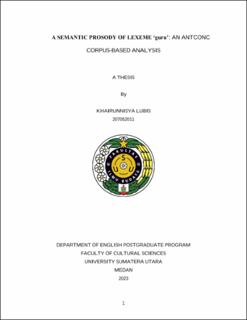| dc.description.abstract | This study analyzes the semantic prosody types, the collocation types and how are they interpreted in the speeches of Nadiem Makarim using AntConc. The study analyzed a corpus of 32 texts from different sources and applied the semantic theory of prosody to identify the underlying connotations and associations of the lexicon used in the language uses descriptive qualitative method based on Stewart. The findings in this paper have shown that there are 584 sentences, 1009 lexemes guru from 16.449 tokens found and divided into 267 (45.71%) positive, 269 (46.06%) neutral, and 48 (8.2%) negative semantic prosody. All lexemes guru that collocates with another lexeme most likely appears in lexical collocations and only 1 collocation that belongs to grammatical collocation. Guru is used to collocate with another noun, pronoun, that clause and adjective like guru penggerak, guru PAUD, guru honorer, guru-guru, guru yang, guru kepala, guru pesantren,guru lain, guru gurunya,guru tenaga, guru se-, guru dosen, guru itu, guru dan, guru SD, guru Indonesia, guru PNS, guru non, guru swasta and guru terbaik. The result of semantic prosody types and collocation could interprete NM speeches where he highlighted four key issues related to teachers, including appreciation and gratitude to the teachers, improving Indonesia quality of education, improving teacher welfare and the important role of teachers in Indonesian education. The results also highlight the overt and implicit connections between language use and the social realities of its users and elucidate the influence of language on the formation of perceptions and attitudes in educational contexts using semantic prosody.This study contributes to the understanding that lexical choices in a language can convey relevant textual information, allowing for a deeper understanding of lexical meanings and values and insights into the speaker's identity. | en_US |


